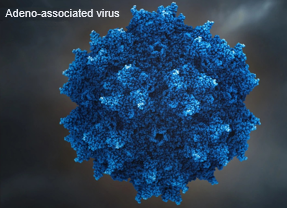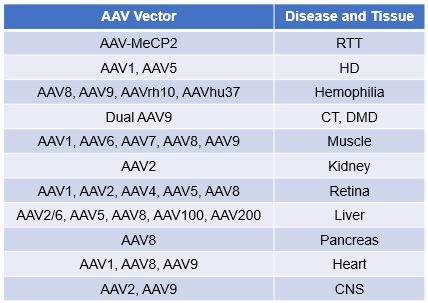Adeno-associated Virus Vector

Introducing new genetic material into target cells without causing toxicity to non-target tissues is the goal of cancer gene therapy. The adeno-associated virus (AAV) is a small virus that allows packaging of only 4 kb inserts. AAV has low toxicity, apparent lack of pathogenicity and provides long-term transgene expression through chromosomal integration. Using the basic principles of molecular biology and laboratory techniques, Creative Biolabs provides a wide variety of AAV vectors for both basic research and clinical applications.
Adeno-associated Virus Vector Construction
The AAV genome contains two genes, rep and cap, encoding polypeptides essential for the replication and encapsidation of AAV. These two genes are flanked by viral ITRs. AAV requires co-infection with another helper virus (adenovirus or HSV) to mediate their replication. The relatively small ITRs greatly reduce the level of inducted cellular immune response and improve the safety of AAV vectors in human clinical applications. AAV serotype 2 (AA2) is the first and best characterized infectious clone to have been widely used to transduce neurons.
 Fig.1 Schematic of the basic components of AAV vector
Fig.1 Schematic of the basic components of AAV vector
For the purpose of strengthening the tissue tropisms and avoiding the immune response triggered by repeated administration, multiple serotypes of AAV are applied to human gene therapy, each with a different targeting capacity. To improve the transduction ability of certain tissues, Creative Biolabs offers different retargeting methods for the insertion of small peptides or ligands directly into the viral capsid sequence or the mutagenesis of the AAV2 capsid. In addition, the bispecific antibody or biotin is used that interacts with both the viral surface and the specific cell surface receptor and mediates indirect targeting. We also provide dual AAV vectors to address the issue that limited the packaging capacity of foreign DNA into recombinant AAV particles.
 Fig.2 Examples of gene therapy applications
Fig.2 Examples of gene therapy applications
Delivery Potential of Adeno-associated Virus Vector
AAV is an important candidate as a therapeutic gene transfer vector that has been used successfully to transfer antisense or ribozyme genes in pre-clinical cancer models. AAVs can be used to treat some diseases, such as Rett syndrome (RTT), cerebrospinal fluid (CSF), Alpha-1 antitrypsine deficiency (AAT), Huntington's disease (HD), hemophilia A, Duchenne and limb girdle muscular dystrophies, cystic fibrosis (CT) and Leber congenital amaurosis.
SERVICES
Aided by our first-class platform and scientific team, Creative Biolabs provides a collection of AAV services, including but not limited to: vector design, purification, titration, toxicity and safety determination. These all-around services can meet customers' demands in basic research and preclinical applications.
Features
- Relatively broad host range: transduce both dividing and non-dividing cells
- Non-pathogenic
- Slow expression onset
- Chromosomal integration: persistent long-term nature
- Reduce the amount of injected viruses by choosing the best AAV serotype
We also provide recombinant adeno-associated virus vector products containing various promoters and shRNA-encoded genes.
Creative Biolabs has focused on designing AAV vectors to change tropism, enhancing delivery efficiency and evading antibody neutralization. We provide novel molecular engineering and directed evolution approaches for AAV vectors to yield enhanced AAV gene delivery vectors to meet our clients' demands. Please feel free to contact us for more details and we are pleased to offer you the best services.
Reference
- Kenneth Lundstrom. (2018). Viral Vectors in Gene Therapy. Diseases, 6(2): 42.
